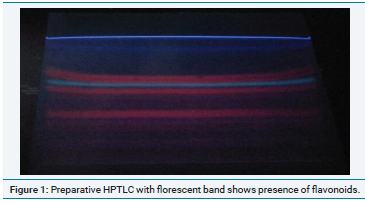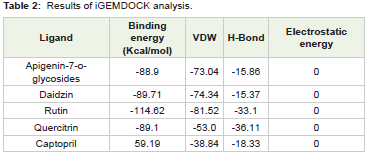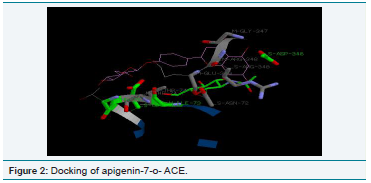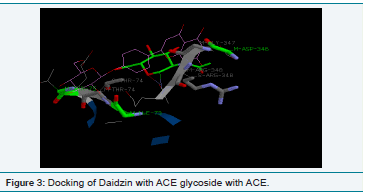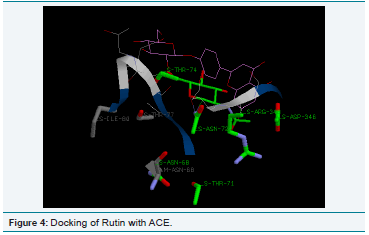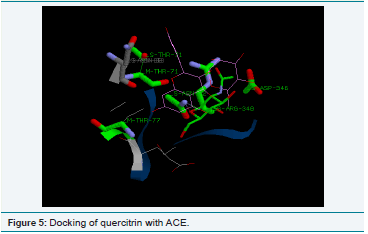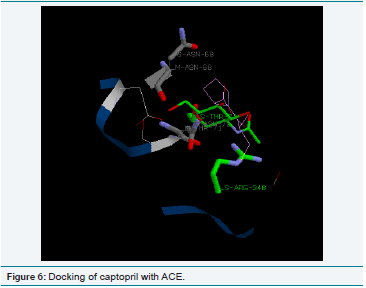Research Article
Isolation of Flavonoids from Ocimum sanctum L. and its Docking Study as Angiotensin Converting Enzyme (ACE) Inhibitors
Patel H* and Gamit D
Department of Biosciences, Veer Narmad South Gujarat University, India
*Corresponding author: Patel H, Department of Biosciences, Veer Narmad South Gujarat University, Surat, Gujarat, India, Email: hinalbiotech@gmail.com
Copyright: © Patel H, et al. 2020. This is an open access article distributed under the Creative Commons Attribution License, which permits unrestricted use, distribution, and reproduction in any medium, provided the original work is properly cited.
Article Information: Submission: 07/02/2020; Accepted: 16/03/2020; Published: 20/03/2020
Abstract
Hypertension is one of the most common health problems that carry a high risk of stroke, myocardial infection and renal disease. ACE is one of the important enzymes that responsible for hypertension. Ocimum sanctum plant is very important for their therapeutic potential. There are so many phytochemicals are present in Ocimum sanctum among which flavonoids are most important for their health benefits. In present study prepared flavonoid extract from Ocimum sanctum leaves using methanol and ethyl acetate solvent. Isolate flavonoids from prepared solvent extract using preparative HPTLC method and identified it with the help of HRLC-MS/Q-TOF technique. Molecular docking study was conducted using iGEMDOCK V.2 windows software to
find out efficiency of isolated flavonoids with ACE along with standard drug. This information can be further utilized for design of potential therapeutic drug from plant flavonoid in regulation of hypertension.
Introduction
Hypertension is the most common serious persistent health
problem that carries a high risk of arteriosclerosis, stroke, myocardial
infarction and end stage renal disease [1]. Angiotensin converting
enzyme inhibition is one of the Morden therapeutic approaches to
treat hypertension [2]. ACE catalyses the degradation of bradykinin
[3]. ACE also converts angiotensin I into potent vasoconstrictor
angiotensin II [4]. Therefore to generate antihypertensive effect,
inhibition of ACE is required. Captopril, enalapril like synthetic
drugs are widely used to treat hypertension but they show some
major side effects like renalin fatigue, angioneurotic edema etc. so
there is a requirement of new Natural based ACE inhibitors that
greatly beneficial to hypertensive patients.
Natural has many useful plants and herbs for human beings.
The attention paid by health authorities to use of herbal medicine
has increased considerably to meet its health needs. Medicinal
plants are rich in secondary metabolites like alkaloids, flavonoids,
glycosides, tannins and essential oil which are good source of drugs
in pharmaceutical industries [5,6]. Among the plants having the
medicinal value, the plants of genus Ocimum belongs to the family
labiacea are very important for their therapeutic potential [7]. Ocimum
sanctum has been used for thousands of the year in Ayurveda for its
healing and other medicinal properties. In Hindu tradition, Ocimum
sanctum get important symbol. Ocimum sanctum is a herbal remedy
for many common ailments like healing power , fever, common cold,
sore throat, anti-inflammatory action, antibacterial etc.
Secondary metabolite like flavonoids – A product of secondary
metabolism produced by plant in higher amount and distributed
widely in plant kingdom. Flavonoids represent a one of the important
class of phytochemicals. They belong to group of polyphenols that
are present in fruits, vegetables, medicinal plants and its products.
Interest in isolation and structure elucidation of many natural
flavonoids get increasing because of its ecology and health benefits of bioactive flavonoids. They are renowned for their number of
health [8]. Phenolic compounds such as ferulic acid and tannic
acid and flavonoids such as quercetin, anthocyanins, flavones and
flavonols have shown to exhibit a capacity to inhibit different zinc
metalloproteinases, including ACE [9,10].
Molecular docking is a very important tool useful in the structure
based rational drug designing. Using iGEMDOCK software of
molecular docking, enzyme interact with ligands like smaller
molecules such as inhibitors or drug candidate to form stable complex.
The main object of this study was to extract flavonoids from
Ocimum sanctum leaves extract using solvent maceration method and
get isolated using preparative HPTLC and identified by HRLCMS/QTOF
technique. Then to perform molecular docking of that identified
flavonoids (inhibitors) with ACE, to determined its binding efficacy.
Materials and Methods
Extraction of flavonoids:
Dried leaves powdered of Ocimum sanctum plant (50 gm)
extracted with direct methanol (95%) by maceration method for 24
h in shaking condition.The extract was filtered and evaporated in vacuum condition.
The filtrate obtained was resuspended in ethyl acetate and extract it
successively to yield ethyl acetate fraction following the method [11]
with some modification.
Preparative High Performance Thin Layer Chromatography:
High performance thin layer chromatography was carried out
after successful development of TLC plate by using toluene: ethyl
acetate solvent system. HPTLC was carried out using CAMAG HPTLC
system for prepared flavonoid extract. Prior to sample application,
activate HPTLC plate (silica gel 60 F254, Merck) at 100 oC for 30 min.Impregnated 200 μl of prepared extract on HPTLC plate (20×20)
as a single band of 180 mm length using CAMAG automatic TLC
sampler III (CAMAG, Switzerland).The plate was then air dried and
kept for development in the twin trough chromatographic chamber
containing 200 ml standardized solvent system, toluene: ethyl acetate
(9.3:0.7).
As the above procedure, 5 HPTLC plates were impregnated
with 200 μl of same sample same as performed for the above plate.
Examine under UV chamber at 366 nm wavelength, after the
successful development of plates.
Isolation of flavonoid constituent:
The plate which was developed was further proceeded for
isolation of flavonoid constitution. The developed plate was then
marked with graphite tip from 1 to 10 cm with mm marking scale
along the solvent system movement. Put the plate under UV chamber
to mark flavonoid band on the scale. By using sharp scalpel, scratched
the selected area along with silica and collected in Eppendorf tube
and eluted flavonoid constituent from silica gel with ethyl acetate and
pooled the content.The pooled content was evaporated at room temperature to form
concentrated and store in small glass bottle for further analysis.
HR-LCMS/Q-TOF:
Identification of extracted flavonoid from desired plant solvent
extract was analysed by LC/Q-TOF Mass Spectrometer, Agilent
technologies, Bombay India. The HR-LCMS analysis of plant material
was analysed by using UHPLC-PDA detector Mass spectrometer.
Sample was separated on SB-C18 column(2.1×50 mm, 1.8 particle
size). The solvents used were Water: Methanol. MS detection was
performed in MS /Q-TOF Mass spectrometer.Molecular Docking
Identified flavonoids through HR-LCMS get derived from
PubChem in 3D structure along with standard drug, captopril.
Convert their structure in mol. Format using software OPENBABEL.
Three dimensional experimentally determined X-ray crystal structure
of Angiotensin converting Enzyme (ACE) were taken from protein
data bank(PDB)(www.rcsb.org/) having PDB code108A. Once
the ligand and protein have been prepared, download the file in
iGEMDOCK software. Docking was performed using iGEMDOCK
software. At the end of each run, compare the binding of ligand
and protein by binding energy i.e. the lowest energy shows highest
binding affinity.
Result and Discussion
Cardioprotective potential of flavonoids gained more interest
in research for other potential properties [12]. Flavonoids or their
derivatives are widely used as pharmaceutical agents for their
Vasoprotective properties [13]. Flavonoids have been extracted from
the leaves of Ocimum sanctum using methanol and ethyl acetate as a
solvent and prepared concentrated extract in ethyl acetate. Thin layer
chromatography process confirmed the presence of flavonoids by
observing the florescent band. Extraction method of phytochemicals
is one of the most important procedure in pharmaceuticals use
of plant species having medicinal importance [14]. Now a day in
botany, HPTLC become very useful technique for pattern generation,
separation and further isolation. The crude flavonoid extracts revealed
brown, one bright florescent band along with light blue band. The
clear bright blue florescent band was considered to be possible
flavonoids and was selected for isolation (Figure 1).
HRLC-MS analysis lead to the identification of flavonoids from
leaves extract of Ocimum sanctum which showed the presence of
four flavonoids are tubulated (Table 1). Identified flavonoids were
Daidzin, Apigenin, and Rutin and Quercitrin. Retention time, molecular formula, m/z value were evaluated in (Table 1). Nature,
molecular formula and structure of flavonoids compounds were
analyzed by using mass spectrometer at different time. In these,
appearances of peaks are due to large compounds splits into small
ones at various m/z ratios and these HRLC-MS spectra are fingerprint
of that compounds and it identified with data library [15]. The
cleaned and optimized structure of identified flavonoids was derived
from PubChem. 3D structure of ACE was derived from PDB. All
the procedure has been performed using iGEMDOCK V.2 windows
software. Flexible docking has been done between ACE and identified
flavonoids. And also between ACE and standard drug captopril. Low
energy with high binding affinity of flavonoids with ACE is given in
(Table 2). Best conformation with highest binding affinity with low
energy have been chosen for the protein-ligand interaction study and
shown in Figure 2-6.
Conclusion
In most of the studies, it have been shown that plant extracts rich
in phytochemicals found to be very effective in angiotensin converting
enzyme (ACE) inhibition. It can be conclude that, Ocimum sanctum
contain flavonoids, that may important for the ACE inhibition. The
above stated procedure is say to be an efficient and simple workout
for the isolation of compounds from plant extract. Present molecular
modeling studies demonstrated that isolated flavonoids have as same binding efficiency as standard drug. There for these compounds may
be an effective therapeutic candidate for control of ACE. Further
studies with structural modification are required to develop potential
therapeutic entities for the treatment of hypertension and related
disorder.

